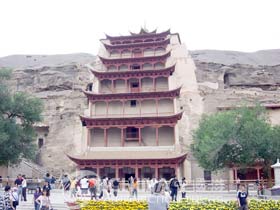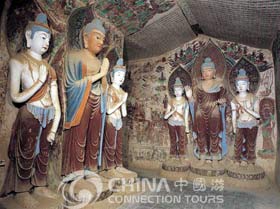 The Mogao Grottoes (also known as Thousand Buddha Cave), twenty-five kilometers southeast of Dunhuang City, is one of three noted grottoes in China and also the largest and richest treasure trove of stone carvings and mural paintings in China. Carved out along a 1,500-meter precipice, the 492 grottoes stretch from south to north on the eastern slope of Singing Sand Dunes (Mingshashan) and are divided into five levels. They contain 45,000 square meters of murals 2,415 painted statues, and five wooden structures. These murals, if joined together, would cover a length of 30 kilometers. The caves vary in size. The smallest one just allows a head's space, while the largest one stretches from the foot to the top of the mountain, having a height of over 40 meters. The colored statues also differ in size, ranging from a few centimeters to 33 meters high, embodying the remarkable imagination of their makers. The statues were all made of clay and colored with paint. Themes of the murals range from Buddha portraits and Buddhist stories to fairy tales and pictures of worshippers.
The Mogao Grottoes (also known as Thousand Buddha Cave), twenty-five kilometers southeast of Dunhuang City, is one of three noted grottoes in China and also the largest and richest treasure trove of stone carvings and mural paintings in China. Carved out along a 1,500-meter precipice, the 492 grottoes stretch from south to north on the eastern slope of Singing Sand Dunes (Mingshashan) and are divided into five levels. They contain 45,000 square meters of murals 2,415 painted statues, and five wooden structures. These murals, if joined together, would cover a length of 30 kilometers. The caves vary in size. The smallest one just allows a head's space, while the largest one stretches from the foot to the top of the mountain, having a height of over 40 meters. The colored statues also differ in size, ranging from a few centimeters to 33 meters high, embodying the remarkable imagination of their makers. The statues were all made of clay and colored with paint. Themes of the murals range from Buddha portraits and Buddhist stories to fairy tales and pictures of worshippers.
In AD 366, during the Eastern Jin Dynasty, a monk named Yue Seng chiseled the first cave here. The endeavor continued through later dynasties, including the Northern Wei (386-534), Western Wei (535-556), Northern Zhou (557-581), Sui (581-618), Tang (618-907), Five Dynasties (907-960), Song (960-1279), Western Xia (1038-1227) and Yuan (1279-1368), resulting in the fantastic group of caves that can been seen today.
Their discovery at the beginning of the century, after several hundred years of oblivion, caused a sensation throughout the world. The colored paintings of the Mogao Grottoes feature hold lines, bright colors, and superb composition. Those made during the Tang Dynasty (618-907) are particularly brilliant. A large number of historical documents dating from the Middle Ages were also discovered in a cave where Buddhist scriptures were stored. The study of these valuable materials, along with paintings and statues, has become a subject of worldwide research.
 Despite years of erosion, the murals are still brightly colored, with clear lines. Through pictures of different styles and schools drawn in different historical periods, they tell Buddhist stories and ways as well as life in the secular world. All these, plus a largest quantity of Buddhist sutras and relics kept in the caves have provided valuable material for a study of ancient China's politics, economy, and culture and arts, as well as its science and technology, military affairs, and religion, documenting national history as well as cultural exchanges between China and the world.
Despite years of erosion, the murals are still brightly colored, with clear lines. Through pictures of different styles and schools drawn in different historical periods, they tell Buddhist stories and ways as well as life in the secular world. All these, plus a largest quantity of Buddhist sutras and relics kept in the caves have provided valuable material for a study of ancient China's politics, economy, and culture and arts, as well as its science and technology, military affairs, and religion, documenting national history as well as cultural exchanges between China and the world.
In 1987, UNESCO placed the Mogao Grottoes under the protection of the world cultural heritage list.

